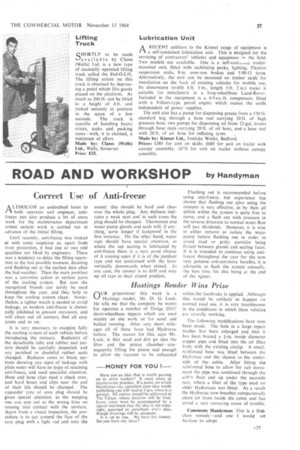ROAD AND WORKSHOP by Handyman
Page 59

If you've noticed an error in this article please click here to report it so we can fix it.
Correct Use of Anti-freeze
A LTHOUGH an undoubted boon to rl both operator and engineer, antifreeze can also produce a lot of extra work for the maintenance department unless certain work is carried out in advance of the initial filling.
Until recently, anti-freeze was looked at with some suspicion as, apart from frost protection, it had one or two odd qualities not liked by engineers. There was a tendency to delay the filling operation to the last possible moment, draining and flushing out at the earliest date after the bad weather. Then the main problem was a corrosive action in certain parts of the cooling system. But now the recognized brands can safely be used throughout the year, and they help to keep the cooling system clean. Nevertheless, a tighter watch is needed to avoid leakage, as modern anti-freeze is chemically inhibited to prevent corrosion, and will clean out all corners, find all easy joints and so on.
It is very necessary to exarpine fully the cooling system of each vehicle before introducing the mixture. Radiators of the detachable tube and rubber seal pattern should be carefully inspected, and any perished or doubtful rubber seals changed. Radiator cores or block sections showing any signs of leakage with plain water wi.11 have no hope of retaining anti-freeze, and need specialist attention. Hose and hose clips need a check over, and hard hoses and clips near the end of their life should be changed. The expander type of core plug should be given special attention, as the weeping one can pop out at the wrong time on coming into contact with the mixture. Apart from a visual inspection, the procedure is to tap around the face of the core plug with a light rod and note the sound: this should be hard and clear over the whole plug. Any dullness indicates a weak spot and in such cases the plug should be changed. Thermostat and water pump glands and seals will, if anything; serve longer if leakproof in the first instance. On the other hand, water taps should have special attention, as where the tap seating is lubricated by anti-freeze there is a very good chance of it coming open if it is of the pendant type and not positioned with the lever vertically downwards when closed. In any case, the answer is to drill and wire up all taps in their closed position.
Flushing out is recommended before using anti-freeze, but experience has shown that flushing out after using the mixture is very effective, as by then all debris within the system is quite free to move, and a flush out with pressure in the reverse direction to normal water flow will pay dividends. However, it is wise to either remove or isolate the water pump before flushing out in order to avoid mud or gritty particles being forced between glands and sealing faces. If it is intended to continue using antifreeze throughout the year for the now very genuine anti-corrosive benefits, it is advisable to flush the system annually, the best time for this being at the end of the wjnter.
























































































































